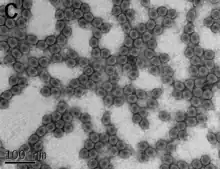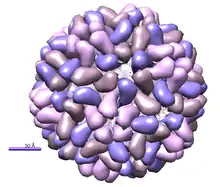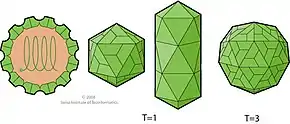| Bromoviridae | |
|---|---|
 | |
| Transmission electron micrograph of brome mosaic virus (BMV) virions | |
 | |
| Crystal structure of Brome mosaic virus, PDB entry 1js9[1] | |
| Virus classification | |
| (unranked): | Virus |
| Realm: | Riboviria |
| Kingdom: | Orthornavirae |
| Phylum: | Kitrinoviricota |
| Class: | Alsuviricetes |
| Order: | Martellivirales |
| Family: | Bromoviridae |
| Genera | |
|
Alfamovirus | |
Bromoviridae is a family of viruses.[2] Plants serve as natural hosts. There are six genera in the family.[3][4]
Taxonomy
The following genera are assigned to the family:[3]
Structure
Viruses in the family Bromoviridae are non-enveloped, with icosahedral and bacilliform geometries. The diameter is around 26-35 nm.[3][4]

| Genus | Structure | Symmetry | Capsid | Genomic arrangement | Genomic segmentation |
|---|---|---|---|---|---|
| Ilarvirus | Icosahedral | T=3 | Non-enveloped | Linear | Segmented |
| Anulavirus | Icosahedral | T=3 | Non-enveloped | Linear | Segmented |
| Bromovirus | Icosahedral | T=3 | Non-enveloped | Linear | Segmented |
| Oleavirus | Icosahedral | T=1 | Non-enveloped | Linear | Segmented |
| Alfamovirus | Varies | Non-enveloped | Linear | Segmented | |
| Cucumovirus | Icosahedral | T=3 | Non-enveloped | Linear | Segmented |
Genomes are linear and segmented, tripartite.[3][4]

Life cycle
Viral replication is cytoplasmic, and is lysogenic. Entry into the host cell is achieved by penetration into the host cell. Replication follows the positive stranded RNA virus replication model. Positive stranded rna virus transcription, using the internal initiation model of subgenomic rna transcription is the method of transcription. The virus exits the host cell by tubule-guided viral movement. Plants serve as the natural host. Transmission routes are mechanical and contact.[3][4]
| Genus | Host details | Tissue tropism | Entry details | Release details | Replication site | Assembly site | Transmission |
|---|---|---|---|---|---|---|---|
| Ilarvirus | Plants | None | Viral movement; mechanical inoculation | Viral movement | Cytoplasm | Cytoplasm | Mechanical inoculation: insects; contact |
| Anulavirus | Plants | None | Viral movement; mechanical inoculation | Viral movement | Cytoplasm | Cytoplasm | Unknown |
| Bromovirus | Plants | None | Viral movement; mechanical inoculation | Viral movement | Cytoplasm | Cytoplasm | Mechanical inoculation: insects; contact |
| Oleavirus | Plants | None | Viral movement; mechanical inoculation | Viral movement | Cytoplasm | Cytoplasm | Mechanical inoculation: insects; contact |
| Alfamovirus | Plants | None | Viral movement; mechanical inoculation | Viral movement | Cytoplasm | Cytoplasm | Mechanical inoculation: insects |
| Cucumovirus | Plants | None | Viral movement; mechanical inoculation | Viral movement | Cytoplasm | Cytoplasm | Mechanical inoculation: insects; contact |
References
- ↑ Lucas, R. W.; Larson, S. B.; McPherson, A. (2002). "The crystallographic structure of Brome mosaic virus" (PDF). Journal of Molecular Biology. 317 (1): 95–108. doi:10.1006/jmbi.2001.5389. PMID 11916381.
- ↑ Bujarski, J; Gallitelli, D; García-Arenal, F; Pallás, V; Palukaitis, P; Reddy, MK; Wang, A; ICTV Report, Consortium (August 2019). "ICTV Virus Taxonomy Profile: Bromoviridae". The Journal of General Virology. 100 (8): 1206–1207. doi:10.1099/jgv.0.001282. hdl:11586/301641. PMID 31192783.
- 1 2 3 4 5 "ICTV Report Bromoviridae".
- 1 2 3 4 "Viral Zone". ExPASy. Retrieved 15 June 2015.